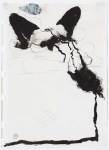While Rabelais’ Gargantua proposes that the walls of Paris be built with genital organs (‘cheaper than stones’), the Vienna Actionists set about refashioning their city not just with organs, but also coagulated blood, entrails, dead animals, garbage, faeces, and, of course, copious buckets of paint. The group’s civic work extended likewise to the modern body, attempting to undo the effects of rationalised mechanisation into a corporeal resplendence that was in no respect bloodless. In working to belie the gilded hypocrisy of their city and its population, Günter Brus, Hermann Nitsch, Otto Muehl, and Rudolf Schwarzkogler employed a grotesque system of images and objects. Their early work, ranging from 1960–66, is on show at Hauser & Wirth’s uptown location in ‘Rite of Passage: The Early Years of Vienna Actionism’ curated by Hubert Klocker.
Materialbild (Material Painting) (1961), Otto Muehl © ARS, NY. Photo: Stefan Altenburger Photography Zürich

The works brought together for this show range in medium from maxi pads to mimeographs, and in size, from Günter Brus’ 1963 expressionist monochrome – extending over 15 feet – to the postage-sized contact prints of Schwarzkogler. Hanging challenges may have been eased by the gallery’s recent renovations. Certainly the space’s division into smallish well-appointed rooms is appropriate for works by artists who eschewed the de-humanised architecture of industry and bureaucracy.
Hermann Nitsch’s architectural concerns developed into a proliferating mass of sketches and plans for his notorious Orgies Mysteries Theater that he intended to build in pullulating passageways and uterine rooms, all underground. Nitsch was also the most prolific painter in the group, and his 1961 Kreuzwegstation (Station of the Cross) in the painter’s compulsory red is on display to staggering effect. The colour, however, is in no way restrictive: adjacent paintings on the second floor exhibit desiccated reds alongside the horribly juicy. There is only one dark-hued painting, in black-green rhizomic streaks, that attests to Nitsch’s subterranean commitments – only ‘under the earth is there room enough’, he writes, for sensory experience – and the painting’s punctuation with Prussian blue reminds us that blood is blue in the veins.
Installation view, Hauser & Wirth New York, 69th Street, 2014 © 2014 Artists Rights Society (ARS), New York / Bildrecht, Vienna. Courtesy Hauser & Wirth. Photo: Genevieve Hanson

Possibly the most difficult to stomach of several action-oriented contemporary movements – namely Fluxus, Gutai, Situationism, and the Happenings of the ‘60s – this body of work is difficult in other respects as well. It requires at least a renunciation of conventional good taste, and intimate appreciation demands a revision of our most closely observed taboos. At the very least, the work effects knee-jerk somatization and, in its most idealistic aims, a desubjectified sense of renewal that goes beyond ‘self’.
‘RITE OF PASSAGE: The Early Years of Vienna Actionism, 1960–1966’ is at Hauser & Wirth, New York, until 25 October.





